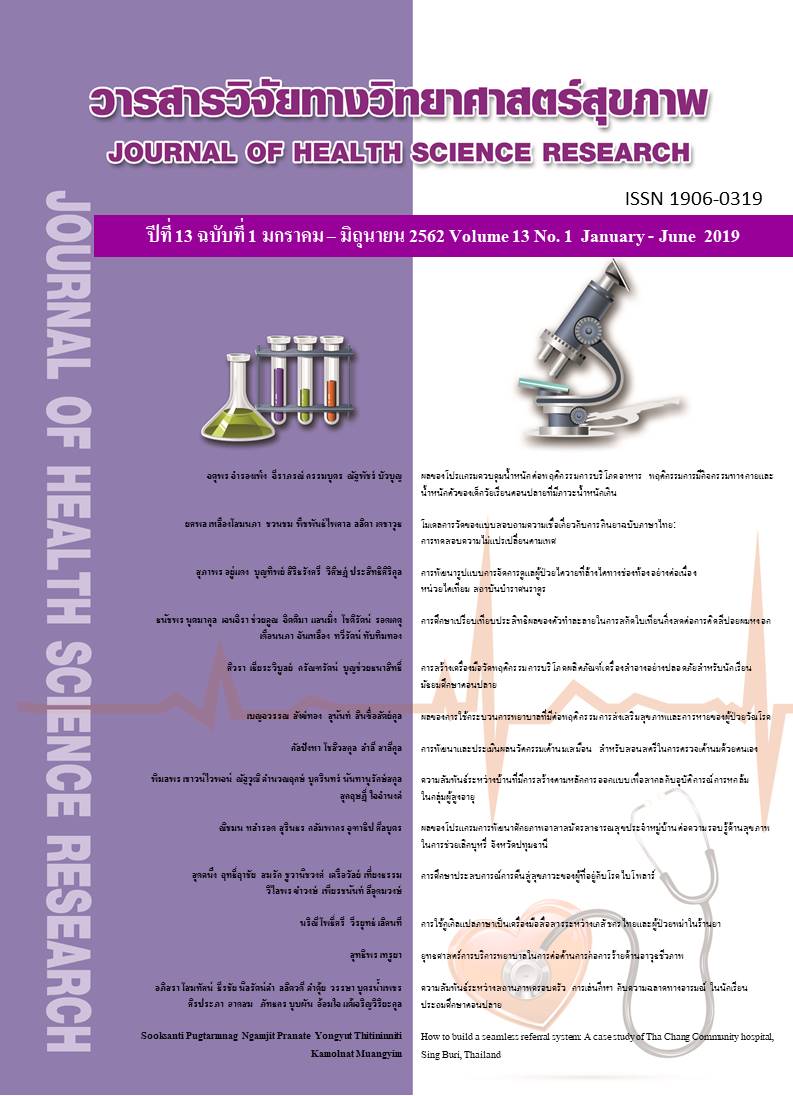ยุทธศาสตร์การบริการพยาบาลในการต่อต้านการก่อการร้ายด้านอาวุธชีวภาพ
Main Article Content
บทคัดย่อ
การศึกษาวิจัยนี้มีวัตถุประสงค์ เพื่อกำหนดยุทธศาสตร์การบริการพยาบาลในการต่อต้านการก่อการร้ายด้านอาวุธชีวภาพของสถาบันบำราศนราดูร และ กำหนดสมรรถนะที่จำเป็นนอกเหนือจากสมรรถนะพื้นฐานของพยาบาลวิชาชีพในการดูแลผู้ที่ได้รับผลกระทบจากอาวุธชีวภาพ เก็บรวบรวมข้อมูลโดยการสัมภาษณ์ผู้เชี่ยวชาญด้านอาวุธชีวภาพ และจัดประชุมสัมมนาผู้บริหารการพยาบาล วิเคราะห์ข้อมูลด้วยเทคนิคการวิเคราะห์เนื้อหา และสถิติบรรยาย
ผลการวิจัยพบว่า ยุทธศาสตร์การบริการพยาบาลในการต่อต้านการก่อการร้ายด้านอาวุธชีวภาพประกอบด้วย 6 ประเด็นยุทธศาสตร์ ได้แก่ 1) พัฒนาศักยภาพสู่การเป็นพยาบาลวิชาชีพที่มีขีดความสามารถสูงในการดูแลผู้ประสบภัยจากอาวุธชีวภาพ 2) พัฒนาระบบข้อมูล ข่าวสารและความรู้เกี่ยวกับภัยจากอาวุธชีวภาพให้ทันสมัย 3) เสริมสร้างเครือข่ายในการจัดการและควบคุมภัยจากอาวุธชีวภาพ 4) พัฒนานวัตกรรมและเทคโนโลยีใหม่ๆ เพื่อใช้ตรวจพิสูจน์ทราบ วินิจฉัย และดูแลรักษาพยาบาลผู้ประสบภัยจากอาวุธชีวภาพ 5) พัฒนาระบบการติดต่อสื่อสารให้รวดเร็วแม่นยำและทันสมัยและ 6) เตรียมความพร้อมบุคลากรและผู้เกี่ยวข้องพร้อมแผนปฏิบัติและสิ่งอุปกรณ์สำหรับเผชิญเหตุภัยจากอาวุธชีวภาพ และพบว่าสมรรถนะที่จำเป็นนอกเหนือจากสมรรถนะพื้นฐานของพยาบาลวิชาชีพประกอบด้วยสมรรถนะหลัก 6 ด้าน คือ 1) การพัฒนาความรู้ความชำนาญ 2) การจัดการข้อมูล 3) พฤติกรรมบริการทางคลินิก 4) การป้องกันตนเอง 5) การควบคุมการแพร่กระจายเชื้อ และ 6) การสื่อสารและประสานงาน
ยุทธศาสตร์ที่ได้นี้สามารถนำไปใช้เป็นแนวทางกำหนดแผนปฏิบัติการในการรับมือกับการถูกโจมตีด้วยอาวุธชีวภาพ และสามารถให้บริการพยาบาลดูแลผู้ประสบภัยจากอาวุธชีวภาพเป็นไปตามมาตรฐานสากล
Downloads
Article Details
บทความที่ได้รับการตีพิมพ์เป็นลิขสิทธิ์ของวิทยาลัยพยาบาลบรมราชชนนี จังหวัดนนทบุรี
ข้อความที่ปรากฏในบทความแต่ละเรื่องในวารสารวิชาการเล่มนี้เป็นความคิดเห็นส่วนตัวของผู้เขียนแต่ละท่านไม่เกี่ยวข้องกับวิทยาลัยพยาบาลบรมราชชนนี จังหวัดนนทบุรี และคณาจารย์ท่านอื่น ในวิทยาลัยฯ แต่อย่างใด ความรับผิดชอบองค์ประกอบทั้งหมดของบทความแต่ละเรื่องเป็นของผู้เขียนแต่ละท่าน หากมีความผิดพลาดใด ๆ ผู้เขียนแต่ละท่านจะรับผิดชอบบทความของตนเองแต่ผู้เดียว
เอกสารอ้างอิง
2. Buathong R, Siriarayaporn P, Thammawijaya P, Chuxnum T, Juntasiriyarkorn S. Medical and public health preparation guidelines for responding to emergencies in the case of biological weapons. Bangkok: The War Veterans Organization Office of Printing Mill; 2015 :21-2. (in Thai).
3. Centers for Disease Control and Prevention. Biological and chemical terrorism: Strategic plan for preparedness and response. MMWR Recomm Rep. 2000;49(RR04):1-14.
4. Gwerder LJ, Beaton R, Daniell W. Bioterrorism. Implications for the occupational and environment health nurses. AAOHN J. 2001;49(11):512-8.
5. Jacobson HE, Soto Mas F, Hsu CE, Turley JP, Miller J, Kim M. Self-assessed emergency readiness and training needs of nurses in rural Texas. Public Health Nurs. 2010;27(1):41-8.
6. Caporal A. NCLEX-RN: Disaster nursing: Bioterrorism [Internet]. 2017 [cited 2019 Jan 15]; Available from: https://brilliantnurse.com/ nclex-rn-disaster-nursing-bioterrorism/
7. Centers for Disease Control and Prevention (CDC). Update guidelines for evaluating public health surveillance systems. MMWR Recomm Rep. 2001;50(RR13):1-35.
8. O’Sullivan TL, Dow D, Turner MC, Lemyre L, Corneil W, Krewski D, et al. Disaster and emergency management: Canadian nurses’ perceptions of preparedness on hospital front lines. Prehosp Disaster Med. 2008;23(3):S11-8.
9. Committee on Governmental Affairs, International Security, Proliferation and Federal Services Subcommittee. FEMA’s role in managing bioterrorist attacks and the impact of public health concerns on bioterrorism preparedness. Washington: U.S. Government Printing Office; 2001.
10. Rowney R, Barton, G. The role of public health nursing emergency preparedness and response. NursClin North Am. 2005;40(3): 499-509.
11. Young CF, Persell JJ. Biological, chemical and nuclear terrorism readiness: Major concerns and preparedness for future nurses. Disaster Manag Response. 2004; 2(4):109-14.
12. Mekthon S. Review of vision and strategy, Department of Disease Control, 2016-2020 [Documentation for the workshop]. Nonthaburi: Strategic Development Group Planning Division, Department of Disease Control, Ministry of Public Health; 2015. (in Thai).
13. Working group to prepare a master plan for prevention and control of national infection. Action plan for National Infection Prevention and Control, Phase 1 (2019-2021). Nonthaburi: Department of Disease Control, Ministry of Public Health; 2018. :15-20. (in Thai).
14. Mondy C, Cardenas D, Avila M. The role of an advanced practice public health nurse in bioterrorism preparedness. Public Health Nurs. 2003;20(6):422-31.
15. Nyamathi AM, King M, Casillas A, Gresham LS, Mutere M. Nurses’ perceptions of content and delivery style of bioterrorism education J Nurses Staff Dev. 2007;23(6):251-7; quiz 258-9.
16. Khan A, Levitt AM, Sage MJ. Biological and chemical terrorism: Strategic plan for preparedness and response. Recommendations of the CDC Strategic Planning Workgroup. MMWR Recomm Rep. 2000;49(RR04):1-14.
17. Department of Disease Control, Ministry of Public Health. Mission of Department of Disease Control "20-year strategic framework, Ministry of Public Health (2017-2036)". Nonthaburi: Department of Disease Control, Ministry of Public Health; 2018 (in Thai).
18. Department of Disaster Prevention and Mitigation, Ministry of Interior. Prevention strategy and disaster relief [Internet]. 2012 [cited 2019 Jan 20]; Available from: https://www.disaster.go.th/en/cdetail-8324-disaster_news-199-1/The+


